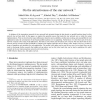Free Online Productivity Tools
i2Speak
i2Symbol
i2OCR
iTex2Img
iWeb2Print
iWeb2Shot
i2Type
iPdf2Split
iPdf2Merge
i2Bopomofo
i2Arabic
i2Style
i2Image
i2PDF
iLatex2Rtf
Sci2ools
JSS
2002
2002
On the attractiveness of the star network
In defiance of the tremendous research the star network had attracted during the last decade, no parallel machine based on this network has yet been built. In this paper, we explore the possible reasons that made the star network not so viable for actual implementation. First we show that the major deficiencies related to poor scalability, cumbersome routing, and unsuitability for real applications make the construction of star-based parallel machines not so appealing. Furthermore, we show that each of the star network variants solves some of the deficiencies, but fails to solve others and introduces new concerns. We also show that the star network and its variants will find it difficult to compete with simpler topologies such as binary cubes, meshes, and k-ary n-cubes in terms of simplicity and suitability for real applications. The results in this paper can be used in two ways. In one hand, they can be used to discourage further research that might end up useless, and on the other h...
| Added | 22 Dec 2010 |
| Updated | 22 Dec 2010 |
| Type | Journal |
| Year | 2002 |
| Where | JSS |
| Authors | Abdel Elah Al-Ayyoub, Khaled Day, Abdullah Al-Dhelaan |
Comments (0)

